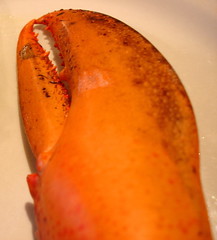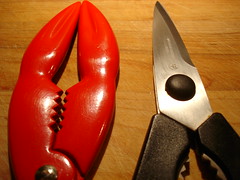Festival du Homard

First, we were regaled with tales of lobster orgies at a former Lindbergh summer home on a secluded Maine island--complete with lobster breakfasts in addition to a series of 2-lobster-per-person dinners--a couple of weekends ago when Team Matador came up for a visit from New York. Then we watched Julia Child's "The Lobster Show" on The French Chef. Traditionally, lobster season around these parts begins around Mother's Day, with peak season for Magdalen Islands lobster lasting from about May 10 - July 10. We were a couple of weeks late in having our very own lobster feast, but at least we'd gotten ourselves properly primed.
Lobster Monday was a miserable Victoria Day or Dollard Day or Patriots' Day or whatever you want to call it (May 22, for those of you tuning in from outside Canada and/or "la Belle Province"). We'd already been thinking about having lobster, but the weather was so depressing that day we decided we needed something good to eat to compensate. We made a trip to Nouveau Falero and when we got there our decision was made. Their lobster tank had a number of feisty fellows bullying their way around, picking fights. We locked eyes with a couple of 1-lb+ specimens and took the poor guys home with us. These were fairly modest lobsters, somewhere in between "chicken" lobsters and "select" lobsters, nowhere near as big as the 4-lb "jumbo" lobster that dominated the tank at Nouveau Falero, not to mention the near-20-lb "behemoth" lobster Child had on her show, or the almost 4-ft long, 45-lb monster that was caught off the coast of Virginia, of all places, in the 1930s--any bigger and they would have really unnerved the cats.
Child's episode had provided us with two possible routes to take with our lobsters: hot and cold, basically. Because of the raw weather that day we were leaning towards the hot version, but there were things about her cold lobster method that appealed to us--namely the way she turned the lobster's "tamale" into a tasty sauce*--so we settled on a "warm" version.
What you need:
1. You need a rather large pot and maybe even a stock pot (if you're cooking more than one lobster or if you've opted for some oversize "Big Bertha"-type lobsters) and you should fill it with salted water and bring it to a vigorous boil.
2. You also need some shell crackers (kitschy "lobster-colored" and "lobster claw-shaped" shell crackers optional) and a good pair of kitchen scissors.
3. Abundant amounts of napkins and/or paper towels are also good to have on hand.
4. Finally, you should have some lemon sections and some drawn butter** on hand. If you're planning on dawdling, you might need one of those contraptions that keeps a sauce warm over a candle or other heat-emitting tool, but we made do without just fine.
Now, you could go frou-frou with your lobster and make a whole host of elaborate dishes with it, like Homard à l'Americaine, Homard à la Bordelaise, or Homard Brillat-Savarin, but there's nothing like the pure simplicity of a boiled or steamed lobster meal, or grilled lobsters if you're feeling a bit more adventurous and you're okay with chopping them into parts live. Somehow keeping it simple takes things back to the days when lobsters were a working-class staple of the coastal-dwelling people of New England, the Maritimes, and Quebec, back before the days when John D. Rockefeller, Sr. and his party were accidentally served a lobster stew intended for the servants downstairs, an unfortunate error that would change the status of the Homarus americanus forever, or so the story goes.***
For a simple boiled lobster meal, you need only toss them into your pot of vigorously boiling water and cook them for 5 minutes per pound. When done, a cooking thermometer inserted into the thickest part of the lobster tail should read 165º F. The only other thing you need to do before serving is to drain the lobster of any excess water that might have filled the exoskeleton during the cooking period--just poke a hole into the lobster's head with a knife and hold it upside-down to allow the water to drain. When that's done you're ready to serve. If you want to cool the lobster so that you can handle it comfortably, you just need to place it under cold running water in a colander.
The Maine lobster is without question the world's most famous lobster, but this has a lot to do with the cultural status of America and the diligent work of the Maine lobster lobby, not to mention the fact that Mr. Rockefeller's apocryphal lobster meal was said to have taken place on his estate on the mysteriously named Mt. Desert Island, just off the coast of Maine. In spite of the celebrity of Maine's lobsters, the American lobster can be found as far south as South Carolina, but the Canadian catch is well over twice as big as that of the United States, and the southern end of the Gulf of St. Lawrence is the world's largest lobster breeding ground. That being the case, there's a good reason that Montrealers have long been serious about their lobsters and that this time of year it's almost hard to find a restaurant that isn't offering some variation on the ubiquitous "Festival d'Homard."
Our first lobster meal of the year was the first time either of us had ever boiled lobsters live, it was also Michelle's very first lobster meal ever (!). I came from a lobster-eating family, Michelle most certainly did not. Boiling the lobsters was kind of a big deal for both of us, but we made peace with our catch and dealt with them as humanely as possible: head-first. I thought I'd seen Michelle at her happiest during a couple of crab meals we had over the last year--one on our trip to San Francisco, and one just a few weeks ago when we had snow crabs here at home. The lobster meal took the cake, though. When it came to eating crab, Michelle was happy to show off her admirable patience and attention to detail. When it came to lobster, though, Michelle found that struggling a lot less but somehow still getting rewarded with enormous pieces of tender lobster meat has its charms. Not only were the cats suddenly a lot less unnerved by the presence of these two crustaceans, they had it the easiest of all. Their lobster meat came fresh and au naturel, with no shell to deal with whatsoever.
aj
*To make this tasty sauce: scoop the "tamale" of each lobster into a bowl. Actually, on second thought, scoop out its tomalley/tomally. What we heard as "tamale" was actually Child saying tomalley (or tomally, as some people prefer). Previously, in all the years I'd eaten lobster, I'd only ever known the tomalley, the lobster's liver, as "that green stuff." Then we watched "The Lobster Show" and I was fascinated to learn that "that green stuff" had an actual name beyond "lobster's liver." Of course, in our ignorance we misunderstood dear Julia: "Oh, that's so cute. It's called the 'tamale.'" Thanks to one of our lobster-savvy readers for setting us straight. Anyway, getting back to the recipe: add homemade mayonnaise, Dijon mustard, minced capers, parsley, and chives. Stir well. Add salt and pepper to taste. If you're not a tomalley person this sauce'll make you a believer; if you are a tomalley person, all the better.
**To make drawn butter: place your butter in a small saucepan and melt it over low heat. When the butter has fully melted, remove it from the heat and set it aside. When the milk solids have settled, pour off the clarified butter on top into a serving dish. That's it.
***Oysters Rockefeller is testament to the fact that John D. had a similar impact on the formerly lowly oyster.









6 comments:
Murderers! Murderers! Karma will get you!
Just thought I'd weigh in on my perferred lobster killing/cooking technique: steaming. The Joy of Cooking says this is the way to do it, and I have to agree. Steam is of a higher temp than boiling water, so the critters succomb faster (at least that's what I tell myself). And just as with steaming veggies, you don't lose as much flavor to the water.
I love reading you blog--thanks! Now a question for you: do you know any pick your own strawberries farms around Montreal? It's getting to be that time of year and I've seen rhubarb in the markets...
Hi Anonymous #2,
I'm not sure I understand how steam can be of a higher temperature than boiling water, but whatever the case, the reading we did indicated that the main issue was "head-first vs. just thrown in."
As for strawberries, I'd recommend heading east, if you can spare the time, and going to someplace like Île d'Orléans, which is famous for its strawberries AND its cream.
As for Anonymous #1,
C'mon. Funny how the dozens upon dozens of other posts having to do with our preparing and eating meats of all kinds--not to mention all those dealing with life post-vegetarianism (in my case) and post-veganism (in Michelle's)--never solicited such a reaction.
If you think my karma's in rough shape (and I'd just love to check out your karmometer readings, champ), imagine Rockefeller's: he ate lobster, he let his servants prepare it for him, AND he owned Standard Oil and virtually invented the petrochemicals industry.
Yes, steaming will be a higher temp than boiling. Remember from chemistry class that water in its gaseous state - AKA steam or vapor - is more disordered at the molecular level and a higher temp than water at its liquid state. This in turn is at least more disordered and at a higher temp than water in its solid state, AKA ice. Another way to think of it is to ask yourself what happens when steam cools? It becomes water and when water boils? It becomes vapor. Hope that helps.
Love your blog, btw.
hi anonymous #3,
thanks for the feedback and thanks for reading--your steam vs. boiling water comparison makes perfect sense--my point was more on the level of ethics--is rapidly boiling water less ethical than steam?--if so, by what degree?--that kind of thing--but anonymous #2's point about losing flavor in boiling water is a good one too--haven't made lobster in quite a few months, but we'll be steaming when we do
Steaming more humane than boiling ?? I don't think so.
Those of you 'would be' scientists may also remember that the energy in 1 litre of boiling water would be far greater than the energy in 10 grams of steam.
A pot of boiling water would maintain a much higher level of heat and energy than a veil of steam which would cool on contact. The heat from the boiling water would continue to conduct into the lobster, killing it (and cooking it) much faster and evenly.
If in doubt, try putting one hand over a pot of boiling water and the other hand in the boiling water. Which do you think you will remove first ??
Post a Comment